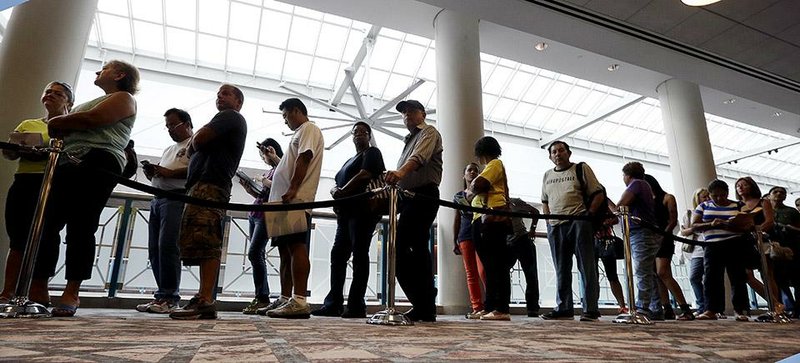WASHINGTON -- U.S. businesses added 213,000 jobs in September, stepping up hiring for the sixth-straight month, according to a private survey.
Payroll processor ADP said Wednesday that the pace of hiring by private employers was up slightly from 202,000 in August. Job gains above 200,000 are usually enough to lower the unemployment rate.
The figures suggest the government's jobs report Friday could reveal a rebound in hiring. The government said employers added only 142,000 jobs in August. But the ADP numbers cover only private businesses and sometimes diverge from the government's comprehensive report. ADP's August figure was much higher than the government's.
Economists surveyed by FactSet forecast that the government's report will show 215,000 jobs were added in September, while the unemployment rate remained 6.1 percent.
The ADP "data add to the evidence that the trend in employment growth remains solid, at least 200,000 per month," said Jim O'Sullivan, an economist at High Frequency Economics.
Other recent job market measures point to strong hiring. The number of people seeking unemployment benefits remains near seven-year lows, evidence that companies are cutting few workers.
Americans are more confident in the economy and are spending more. Consumer spending, adjusted for inflation, increased in August at the fastest pace in six months.
Mark Zandi, chief economist at Moody's Analytics, which helps compile the report, described last month's hiring as broad-based across most industries and company sizes.
Manufacturing firms added 35,000 jobs, more than double the gain in August. That was likely driven by strong hiring by auto companies, Zandi said. Car sales have been healthy all year. Construction companies hired 20,000 workers, down from 23,000 the previous month.
Retailers, shipping companies and utilities added 38,000 jobs in September, and financial services gained 5,000.
U.S. construction spending fell in August, the second decline in the past three months, with housing, nonresidential and government projects all showing weakness.
Construction spending dropped a seasonally adjusted 0.8 percent after a 1.2 percent increase in July, the Commerce Department reported Wednesday. The July increase followed a 1.6 percent June decline.
The weakness was apparent in all sectors. Housing construction declined 0.1 percent, reflecting a big drop in spending on remodeling. Nonresidential construction fell 1.4 percent while spending on government projects dropped 0.9 percent.
In addition to the August decline, the government revised lower its estimates for activity in the previous two months. While this could call into question expectations that building activity will support economic growth in the second half of the year, economists at Barclays said they were leaving their forecast for third-quarter growth unchanged at 3 percent.
Barclays economist Michael Grapen said that though the report signaled a softer start to the third quarter, he was still encouraged with gains shown in single-family and apartment construction.
Overall construction spending totaled $960.96 billion at a seasonally adjusted annual rate in August, 5 percent higher than a year ago.
Manufacturing cooled in September after the strongest rate of growth in three years as U.S. factories settled into a more sustainable expansion that will spur the economy.
Although the Institute for Supply Management's index dropped to 56.6 from 59 in August, the gauge's average over the past three months was the highest since early 2011, figures from the Tempe, Ariz.-based group showed Wednesday.
Rising motor-vehicle sales and growing corporate orders for equipment are keeping the nation's assembly lines busy. Improving consumer and business spending are bolstering American factories at a time global markets from China to Europe show few signs of gaining traction.
"It's signaling a fairly good pace of manufacturing growth," said Michael Moran, chief economist at Daiwa Capital Markets America Inc. in New York. "The labor market is improving at a respectable pace. The economy is expanding at a moderate pace."
Information for this article was contributed by Christopher S. Rugaber and Martin Crutsinger of The Associated Press and by Shobhana Chandra of Bloomberg News.
Business on 10/02/2014
